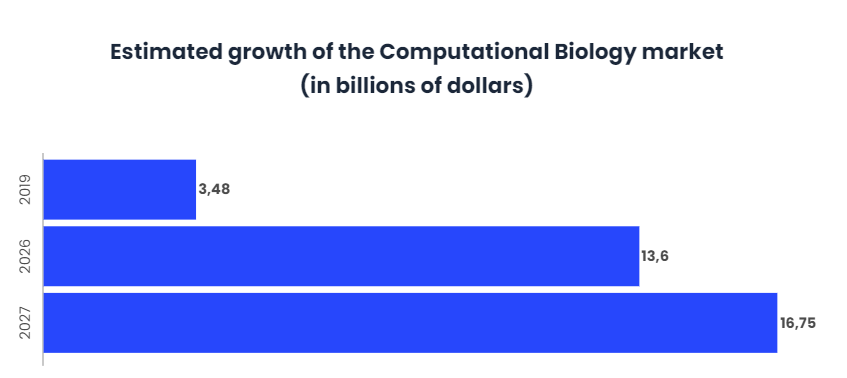Biological computing and computational biology: different objectives

The alliance of computing and biology is not new. In fact, Alan Turing, the British mathematician and cryptographer unanimously considered one of the fathers of computing, used early computers to better understand complex biological processes. He also realized that this alliance could be useful on two different fronts:
- On the one hand, he decided to develop mathematical models of morphogenesis, which is roughly the biological process that explains how an organism acquires a certain form.
- On the other hand, he strengthened the foundations of Artificial Intelligence as a discipline integrated into the computer sciences that aimed to imitate the cognitive capacities of the human mind.
And, surely without intending to, Turing laid the foundation for two disciplines that today have enormous potential: computational biology and biological computing.
How much their names are similar can be confusing, but biological computing and computational biology are not the same thing. They do not pursue the same goal, and their scope of work is not the same either.
Computational Biology
Computational biology is the interdisciplinary science that uses computer tools to help better understand the most complex biological systems. It is the combined application of mathematics, statistics, and computer science to solve biology-based problems, and which stores, analyzes, and interprets the Big Data generated by life science experiments, or clinical data, using computer science. And dedicated data experts.
But what specific tools can computer science offer, beyond programming, to help solve the most complex problems in biology? Simply, all those that are useful when processing large volumes of data to infer new knowledge, such as Big Data, Machine Learning or Quantum Computing.
Several biological analyses result in exponential amounts of biological data and it becomes very difficult to analyse them using manual means. This is where computer science and the tools discussed above come in. Various computational techniques are used to analyze pieces of biological data more accurately and efficiently through automated processes. The knowledge provided by these computer tools is valuable not only for a better understanding of biological systems, but also for creating mathematical models and computer simulations capable of predicting future behaviour. And this has applications in fields as diverse as ecology, neuroscience, pharmacology, genetics and oncology, among other scientific branches.
This field, many scientists, also call it bioinformatics, and although there are others who consider that there are small differences between bioinformatics and computational biology, the truth is that there is no definition that establishes a clear distinction between the two disciplines.
A growing market
Interest in computational biology is growing over the years because of what it can offer and the fundamental problems it can solve. In fact, the global market for computational biology was valued at $3.48 billion in 2019, and is expected to reach $16.75 billion by 2027, at a compound annual rate of 21.7%.

Technological advances have opened the door to a world of innovation in healthcare, where computational biology is gaining strength. Computational genetics is a discipline of computational biology where homology and internal biological mechanism are studied by sequencing the genome. The Human Genome Project is a classic example where the entire human genome was successfully sequenced.
Computational biology also finds application in neurology, where it is used to map complex interlocking pathways to visualize 3D simulation models of the brain. In addition, computational pharmacology also uses computational biology tools to visualize and simulate advanced drug interactions in the drug design process.
Government funding, increased research and development, increased demand for predictive models and application in various sequencing projects, such as the human genome project, are some of the factors supporting market growth during the forecast years.
The Scope of Computational Biology
Three of the areas in which computational biology has the ability to make a difference over the next few years are
- Therapies to increase longevity.
- Immunotherapy.
- Applications of the CRISPR gene editing technique.
There is no doubt that these are three areas of study that can have a very positive impact on people’s lives, but, in reality, this is only a small sample of the scope of computational biology. There are other fields in which this discipline aims to achieve very significant advances:
- Computational neuroscience: deals with the functioning of the brain by analyzing the ability of the structures that make up the nervous system to process information.
- Computational pharmacology: studies the link between the genetic information that a specific organism possesses and the way in which it is affected by a specific type of disease.
- Computational Anatomy: deals with the study of the form that living beings take by analyzing all the scales of their morphology, from the largest structures to the microscopic ones.
- Computational genetics: studies the genetic material of an organism or a species as a whole.
- Computational biology applied to cancer treatment: deals with predicting the mutations that a certain manifestation of this disease will undergo.
- Computational ecology: a branch of computational biology concerned with solving ecological problems.
Biological Computing
For its part, biological computing, is a branch of computer science that studies, on the one hand, how to use elements of a biological nature to process and store information, and also how to be able to draw on the mechanisms of biological evolution to develop new algorithms to solve complex problems.
Therefore, this discipline is divided into two different branches that have applications in different fields of computer science:
- One of them is allowing you to develop hardware from a very different perspective than the one you are familiar with.
- The other is entering the software in the form of one of the most promising branches of Artificial Intelligence.
Biological computers: Hardware
You can’t talk about biological computing without talking about biological computers. There is still a lot of work to be done to get biocomputers out of the labs and to make a difference by helping to solve some very specific problems that are currently difficult to address with conventional computers. Even so, the next few years will see significant progress because they have already done so over the last two decades thanks to the momentum that nanobiotechnology has gained.
Biological computers are made of living cells. Instead of carrying electrical wiring, these computers use chemical inputs and other biologically derived molecules, such as proteins and DNA, to perform computational calculations that involve storing, retrieving and processing data.
Important branch of Artificial Intelligence: Software
The impact of biological computing on hardware is a medium to long-term promise. However, in the software area the situation is very different. This discipline is a very strong branch of artificial intelligence. Its purpose is, as we have seen, to draw on the mechanisms of biological evolution to find the optimal solutions to some complex computational problems.
Some of the most interesting tools it proposes are population-based learning systems; problem solving through evolutionary schemes inspired by biological metaphors, such as genetic algorithms; or artificial neural networks, among other options. These last two strategies can help to understand quite precisely how the mechanisms of biological computing work.
Conclusions
Despite their differences, one thing is clear: both disciplines aim to solve some of the greatest problems facing humanity today.
Many companies have seen the power and potential of both disciplines, for example, Synthego, a Silicon Valley startup, is using a combination of software engineering and hardware automation to become the Amazon of genomic engineering.
Crispr, is revolutionizing the speed and scope with which scientists can modify the DNA of organisms, including human cells.
Microsoft is working on a wide variety of projects with Biological Computing, to turn cells into living computers that could one day be programmed and even reprogrammed to treat diseases such as cancer.
Because thinking and computational techniques are so important to the pursuit of understanding life, virtually all biology today is computational biology. Computational biology brings order to the understanding of life, makes biological concepts rigorous and testable, and provides a reference map that brings together individual ideas.


